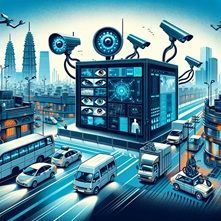Greater Chennai Police (GCP) plans to set up a cloud-based surveillance system to monitor the general public’s and vehicles’ movements by installing cameras on 635 vehicles across police limits. While a similar tender for an automatic number-plate recognition (ANPR) system was already floated by the GCP in February 2023, it is interesting to note that neither of these tenders talk about consent or data erasure rights of citizens.
As per a tender shared by the GCP, the cameras will be used to create a Wi-Fi dashboard that will allow police officers in the area to view livestream of the cameras from their phone and remote devices. A Control Centre (CC) will be able to view all the surveillance feeds and alerts.
In case of a disaster or failure of the data centre, the video feed will “automatically switch to the Disaster Recovery Centre.” This centre will take over the function of the Data Centre. Even in normal situations, the data in the data centre will be replicated in the Disaster Recovery centre automatically in real time.
The dashboard cameras will be functional for a year and will be used for activities like “evidence management, monitoring of patrolling vehicles and use as general surveillance.”
This means that not just public vehicles but the movements of the patrolling police vehicles and their surrounding vehicles will be recorded as well. Similarly, the system will record ‘inside video’ to collect data about driver behaviour. The system will also have a central monitoring of surveillance video and behaviour of the accused while bringing the person to the station.
The entity who gets the tender will have to arrange a two-way communication between patrolling vehicles to reach crime areas in time. The selected bidder will also have to ensure the system provides on-demand and periodic reports for vehicle utilisation, driver behaviour, and additional analytics, suitable for surveillance, etc.
The cameras will support Google offline map, Chinese mapping services Gaode and Baidu as well as a raster map – a kind of digital map whose format is particularly useful in representing continuous spatial phenomena like elevation, temperature, or land use. Other operational features included will be real-time and real-location video monitoring, vehicle history track search, vehicles passing search and positioning trace. The system also has an option to support face recognition cameras if needed.
The surveillance and analysis data collected by these cameras will be kept in the cloud Data Centre for seven days. Similarly, the data will be stored locally for 30 days.








